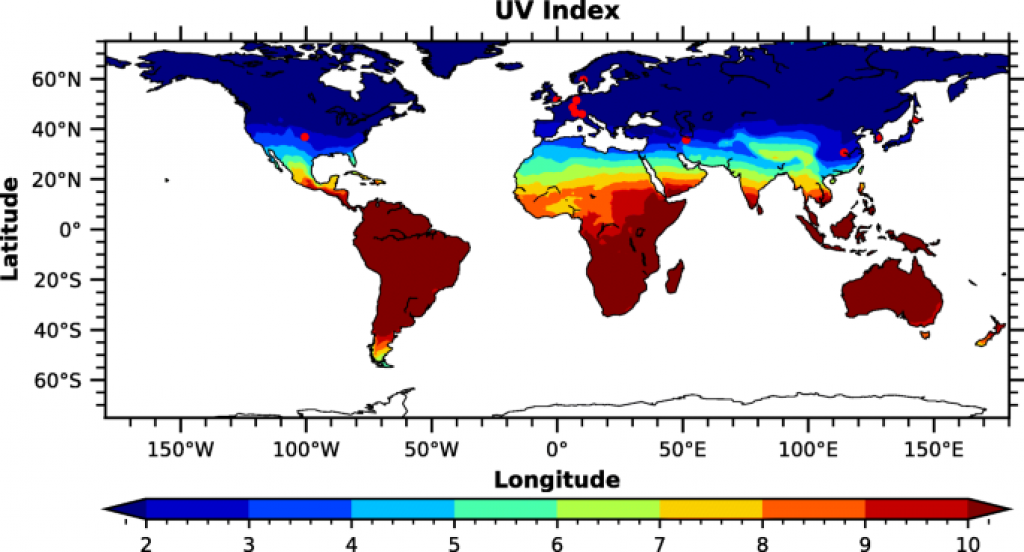The UV index was standardized in 1994 by the National Weather Service (NWS) and the U.S. Environmental Protection Agency (EPA).
What is the UV index?
The UV index is an open-ended linear scale that assists people in making informed decisions with regards to planning outdoor activities based on the intensity of the UV radiation on that specific day. The scale ranges from 1 (safe) to 11 (dangerous).
This article will highlight the importance of the UV index and how you can use it to plan your outdoor activities safely, in accordance with the strength of the sun.
[wpsm_toplist]Table of Contents
What Is The UV Index?

The UV index was developed by Canadian scientists in 1992 and was later adopted and standardized in 1994 by the NWS and EPA.
- Essentially, the UV index is an international measurement that measures the potential sunburn causing Ultraviolet (UV) radiation at a specific location and time.
The UV index is usually integrated into weather and temperature forecasts and is increasingly being made available as an hourly forecast as well.
Ultimately the point of the UV index is to help people protect themselves and their loved ones from high levels of UV radiation that can damage skin, eyes and cause other health-related issues if exposed to in excess.
See also: Solar Panels For Home Use (The Ultimate Guide)
What Is A Safe UV Index?
0 – 2 or green on the UV index scale is regarded as safe levels of ultraviolet radiation. On this level, you can safely suntan or expose your skin directly to the sun with a low probability of serious damage.
However, it is still recommended to cover up and protect your skin using broad-spectrum SPF 30+ sunscreen. We recommend using reef-safe sunscreen like this one. Also, keep in mind that bright surfaces, like sand, water, and snow, exacerbate UV exposure.
UV Index Scale Chart
| UV index | Graphic color | Risk of harm for the average adult | Recommended protection |
|---|---|---|---|
| 0 to 2 | Green | “Low” | A reading of 0 to 2 symbolizes low danger from the sun’s UV rays. It is recommended that you wear polarized sunglasses on very bright days. If you have very sensitive skin, make sure you cover up and use a broad spectrum SPF 30+ sunscreen. |
| 3 to 5 | Yellow | “Moderate” | 3 to 5 equates to moderate risk of harm if you are exposed to the sun and unprotected. During midday the sun is at its strongest, stick to the shade if possible. If you plan your activities outdoors on a 3-5 UV index day, always make sure to wear sun-protective clothing such as UV blocking (polarized) sunglasses and a wide-brimmed hat like this one. Even on cloudy days it is recommended you once again use reef-safe sunscreen lotion at least SPF 30+. |
| 6 to 7 | Orange | “High” | A reading of 6 to 7 means a high risk of getting sun damage from unprotected exposure to the sun’s UV rays. Eye and skin protection are definitely needed. It is recommended that you avoid sun exposure between 10 am and 4 pm. If you must be outside always wear the necessary protective clothing already mentioned. |
| 8 to 10 | Red | “Very high” | A UV index with a reading of 8 to 10 means you are at a very high risk of being harmed from unprotected sun exposure. It is paramount that you avoid the sun between 10 am and 4 pm. If you must be outside make sure to use SPF 50+ reef-safe sunscreen and various other sun-protective clothing |
| 11+ | Violet | “Extreme” | A UV Index reading of 11 is extreme and you should avoid sun exposure at all costs. If you must be exposed to the sun, make sure you take all the precautions possible as skin and eyes can burn within minutes of unprotected exposure. |
Which Country Has The Highest UV Index?

Peak UV radiation occurs within the tropics (high sun, low ozone) at a high altitude site, most notably, in the Southern Hemisphere.
The country with the highest recorded UV index to date has been Cuzco, in southern Peru.
Additionally, further studies, done by scientist Richard McKenzie, found that many high Andes in Bolivia, Chile, and Argentina regularly hit extreme UV index levels higher than 25.
Best Apps And Websites For Monotoring The UV Index
Final Thoughts
Protecting yourself from harmful UV radiation is paramount to a healthy lifestyle. You can reduce the risk of developing skin-related diseases by informing yourself about the UV index and how you can use it to protect your body. We hope this article served as a resource to help you in your quest to understanding ultraviolet radiation a little better.

